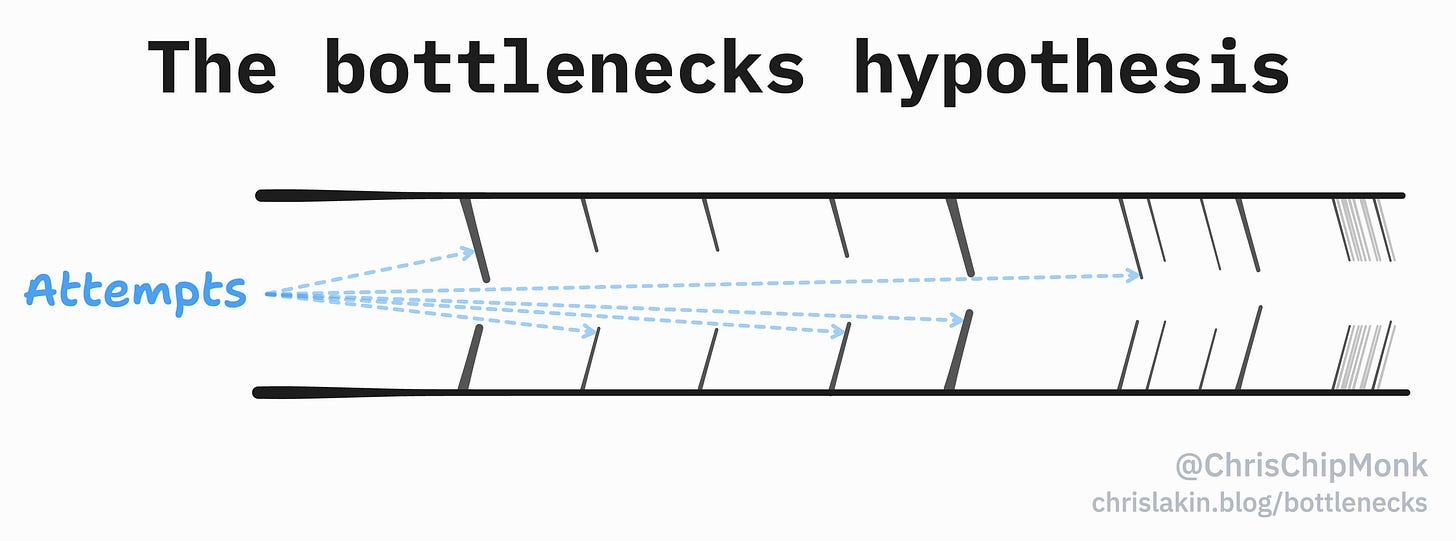The bottlenecks hypothesis
How does highly-resistant insecurity get unlearned?
Some people think they’ve ‘tried everything’ to resolve their insecurity but feel insecure everyday. Meanwhile other people successfully reduced the frequency of these feelings by over 10x. What’s different between these groups?
Through my work with clients, I noticed a pattern: There are high-level bottlenecks to how insecurity that resisted even years of therapy, meditation, and exposure gets unlearned. Progress proceeds when these bottlenecks are targeted in reasonable order, and stalls otherwise.
These bottlenecks behave like valves in a pipe, each restricting natural flow until addressed:
These bottlenecks cluster into two phases: Readiness and Unlearning. Here’s some of how I think about them:
Readiness
Readiness bottlenecks must be addressed before unlearning. They’re what prevent individuals from allocating the time and priority necessary to deeply integrate insights:
Life on fire: Their life had more pressing issues than how they felt— crisis, financial scarcity, severe mental illness; or physical factors, like poor sleep or nutrition that undermined their neuroplasticity. Unlearning required stability, time, and money or social resources they didn’t have.
Denial: They incorrectly believed “I’m not that insecure.”
Hopelessness: They were aware of their insecurity, but still treated it as an immutable trait—“This is just who I am.”
Fear of rocking the boat: Life wasn’t on fire, but risk-aversion prevented commitment—“What if this work decreases my productivity? What if it disrupts my relationships? What if it reduces my free time??”
Lacking scaffolding: They thought they could perform mental surgery on themselves lol.
While readiness bottlenecks were present, they weren’t ready for unlearning and they weren’t ready to become secure.
Unlearning
Eventually, they were ready. A few of the common bottlenecks to unlearning insecurity:
Emotional blindness: When asked how they feel, they went blank or intellectualized.
Self-rejection: Deep shame and self-doubt created an interlocking system that derailed unlearning without them knowing.
Triggers: They easily feel deep self-love, but specific situations still trigger insecurities.
Finally, as these clients released more insecurities, they experienced vanishingly fewer moments of suffering. The rest of the time, they feel a grounded calm (secure).
Order matters
Hearing about my clients’ unsuccessful past attempts has not only supported the bottlenecks hypothesis, but revealed consequences of targeting them out of order: They had attempted deep unlearning before readiness bottlenecks were handled? Their temporary growth was followed by flaky breakthroughs! Worked on triggers while self-rejection was present? New triggers and a brand new shame loop! Or maybe they trained emotional awareness before they were ready to make big changes to their life and mind? They got to feel their existing suffering even more intensely! Overwhelm, increased self-rejection, and learned helplessness were also common.
Put another way, many had been throwing spaghetti at the wall for years: “TRE? Psychedelics?? A meditation retreat??…” This was the opposite of strategically identifying and targeting their current bottleneck. Some of their random experimentation got lucky, but on the whole their search algorithm was suboptimal. Their previous reliance on random experimentation demonstrated poor scaffolding.
On the other hand, when bottlenecks are targeted in order, progress is fast.





Some resonances here with Prochaska’s (much broader-in-scope) “stages of change” model, in case you haven’t come across it: https://en.m.wikipedia.org/wiki/Transtheoretical_model
As with many of your insights, I really like the project of trying to identify and conceptualize sequential bottlenecks, even if the specific sequence you’ve identified strikes me as too idiosyncratic to generalize widely :)
I though I was at the Self-rejection or Triggers bottleneck but I was at Denial 😭😭😭😭